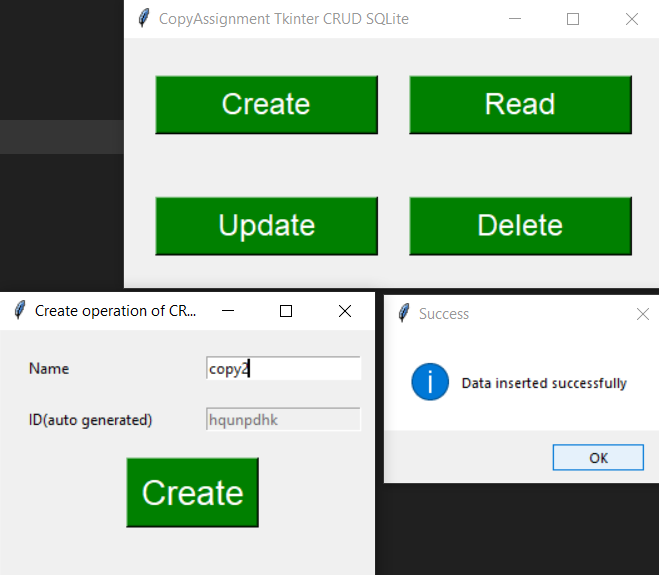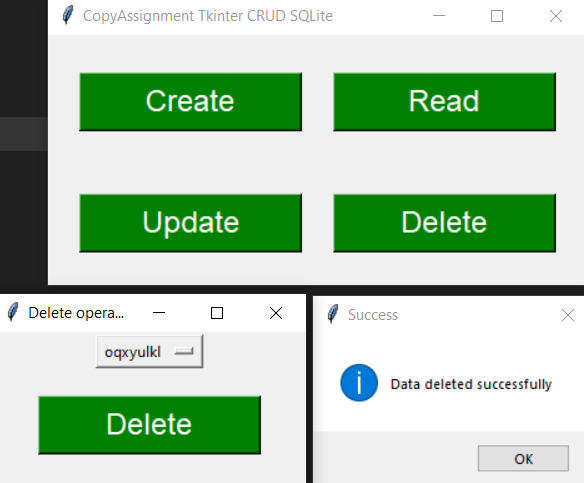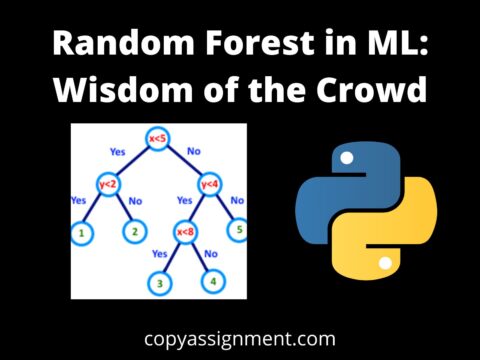
CRUD stands for Create Read Update Delete. I will show you how to perform CRUD Operations in Python. You need basic Tkinter and SQLite knowledge before you read further. This app is straightforward, when you will open this app, a GUI with 4 green colored buttons will open to perform CRUD(create read update delete) operations. SQLite3 library comes inbuilt with Python.
Folder structure for CRUD operations in Python
There are 5 files, and 1 main file handles GUI and works like the driver of the whole application. The other 4 files are there to perform CRUD operations in Python using the SQLite3 database. I have named those files with the CRUD name, making it easy to know which file does what. Check the image below:

So, there are 5 files main.py, create.py, read.py, update.py, and delete.py. The folder(pycache) you are seeing is auto-generated. I will give you the code for each python file separately. You need to create a separate folder with any name and create these 5 files as shown in the image above. You can run this app from main.py file.
Complete code for SQLite CRUD operations in Python
As the code is divided into 5 parts so it’s easy to understand which part does what. For the database part, I have created separate files and performed SQLite CRUD operations with handling errors and exceptions using try and except block. Also, the ID will be auto-generated every time user will create a new row. I have also added a feature of showing the message to the user when he performs a CRUD operation.
main.py
from tkinter import *
import random
import string
top = Tk()
top.title('CopyAssignment Tkinter CRUD SQLite')
top.geometry('430x400')
def CreateOperation():
from create import InsertData
top1 = Tk()
top1.geometry('300x200')
top1.title('Create operation of CRUD')
letters = string.ascii_lowercase
random_id = ''.join(random.choice(letters) for i in range(8))
name = StringVar(top1)
ID = StringVar(top1)
ID.set(random_id)
Label(top1, text='Name').grid(row=0, column=0, padx=20, pady=20, sticky='w')
Entry(top1, textvariable=name).grid(row=0, column=1, padx=20)
Label(top1, text='ID(auto generated)').grid(row=1, padx=20, column=0, sticky='w')
Entry(top1, textvariable=ID, state='disabled').grid(row=1, column=1)
Button(top1, text='Create', fg='white', bg='green', font=('Arial', 20), command=lambda: InsertData(name.get(), random_id)).grid(row=2, column=0, columnspan=2, pady=20)
top1.mainloop()
Button(top, text='Create', bg='green', fg='white', width=12, font=('Arial', 18), command=lambda: CreateOperation()).grid(row=0, column=0, padx=25, pady=30)
def ReadOperation():
from read import Read
top2 = Tk()
top2.geometry('250x200')
top2.title('Read operation of CRUD')
Label(top2, text='Name').grid(row=0, column=0, padx=30, sticky='w')
Label(top2, text=' | ').grid(row=0, column=1)
Label(top2, text='ID').grid(row=0, padx=20, column=2, sticky='w')
Label(top2, text='--------'*5).grid(row=1, padx=20, column=0, columnspan=5)
data = Read()
for i in range(len(data)):
Label(top2, text=data[i][0]).grid(row=2+i, column=0, sticky='w', padx=20)
Label(top2, text=' | ').grid(row=2+i, column=1)
Label(top2, text=data[i][1]).grid(row=2+i, column=2, sticky='w')
top2.mainloop()
Button(top, text='Read', bg='green', fg='white', width=12, font=('Arial', 18), command=lambda: ReadOperation()).grid(row=0, column=1)
def UpdateOperation():
from read import Read
from update import Update
top3 = Tk()
top3.geometry('250x200')
top3.title('Update operation of CRUD')
data = Read()
id_list = []
for i in data:
id_list.append(i[1])
e = StringVar(top3)
e.set('Select ID')
OptionMenu(top3, e, *id_list).pack(pady=15)
name = StringVar(top3)
name.set('New name')
Entry(top3, textvariable=name).pack(pady=15)
def MyUpdate():
Update(name.get(), e.get())
top3.destroy()
Button(top3, text='Update', command=lambda: MyUpdate(), bg='green', fg='white', font=('Arial', 18)).pack(pady=15)
top3.mainloop()
Button(top, text='Update', bg='green', fg='white', width=12, font=('Arial', 18), command=lambda: UpdateOperation()).grid(row=1, pady=20, column=0)
def DeleteOperation():
from read import Read
from delete import Delete
top4 = Tk()
top4.geometry('250x200')
top4.title('Delete operation of CRUD')
data = Read()
id_list = []
for i in data:
id_list.append(i[1])
e = StringVar(top4)
e.set('Select ID')
OptionMenu(top4, e, *id_list).pack()
def MyDelete():
Delete(e.get())
top4.destroy()
Button(top4, text='Delete', bg='green', fg='white', width=12, font=('Arial', 18), command=lambda: MyDelete()).pack(pady=20)
top4.mainloop()
Button(top, text='Delete', bg='green', fg='white', width=12, font=('Arial', 18), command=lambda: DeleteOperation()).grid(row=1, column=1)
top.mainloop()create.py
import sqlite3
from tkinter import messagebox
def Create():
conn = sqlite3.connect('mydatabase.db')
cursor = conn.cursor()
# statement to create a table in sqlite3 using python
cursor.execute("CREATE TABLE IF NOT EXISTS mytable (myname TEXT, id TEXT PRIMARY KEY)")
conn.close()
def InsertData(name, id):
Create()
try:
conn = sqlite3.connect("mydatabase.db")
cursor = conn.cursor()
# statement to insert data into table in sqlite3 using python
cursor.execute("INSERT INTO mytable (myname, id) VALUES (?, ?)", (name, id))
conn.commit()
conn.close()
messagebox.showinfo('Success', 'Data inserted successfully')
except sqlite3.Error as e:
messagebox.showinfo('Error', e)
finally:
conn.close()read.py
import sqlite3
def Read():
conn = sqlite3.connect('mydatabase.db')
cursor = conn.cursor()
# statement to read or fetch all rows from a table in sqlite3 using python
cursor.execute('SELECT * FROM mytable')
all_rows = cursor.fetchall()
conn.close()
return all_rowsupdate.py
from tkinter import messagebox
import sqlite3
def Update(name, id):
try:
conn = sqlite3.connect('mydatabase.db')
c = conn.cursor()
# statement to update a row in sqlite3 using python
c.execute("UPDATE mytable SET myname=? WHERE id=?", (name, id))
conn.commit()
conn.close()
messagebox.showinfo('Success', 'Data updated successfully')
except sqlite3.Error as e:
messagebox.showinfo('Error', e)
finally:
conn.close()delete.py
import sqlite3
from tkinter import messagebox
def Delete(id):
try:
conn = sqlite3.connect("mydatabase.db")
cursor = conn.cursor()
# statement to delete a row in sqlite3 using python
cursor.execute("DELETE FROM mytable WHERE id = ?", (id,))
conn.commit()
conn.close()
messagebox.showinfo('Success', 'Data deleted successfully')
except sqlite3.Error as e:
messagebox.showinfo('Error', e)
finally:
conn.close()Output for SQLite CRUD operations in Python:
Image output:

Create operation

Update operation

Read operation

Delete operation

Video output:
Thank you for visiting our website.
Also Read:
- Create your own ChatGPT with Python
- SQLite | CRUD Operations in Python
- Event Management System Project in Python
- Ticket Booking and Management in Python
- Hostel Management System Project in Python
- Sales Management System Project in Python
- Bank Management System Project in C++
- Python Download File from URL | 4 Methods
- Python Programming Examples | Fundamental Programs in Python
- Spell Checker in Python
- Portfolio Management System in Python
- Stickman Game in Python
- Contact Book project in Python
- Loan Management System Project in Python
- Cab Booking System in Python
- Brick Breaker Game in Python
- Tank game in Python
- GUI Piano in Python
- Ludo Game in Python
- Rock Paper Scissors Game in Python
- Snake and Ladder Game in Python
- Puzzle Game in Python
- Medical Store Management System Project in Python
- Creating Dino Game in Python
- Tic Tac Toe Game in Python
- Test Typing Speed using Python App
- Scientific Calculator in Python
- GUI To-Do List App in Python Tkinter
- Scientific Calculator in Python using Tkinter
- GUI Chat Application in Python Tkinter



